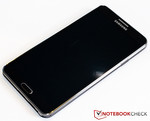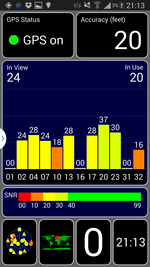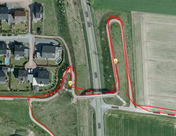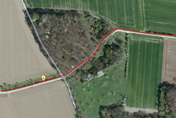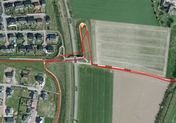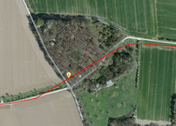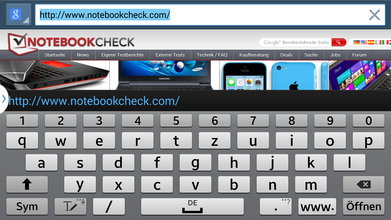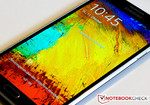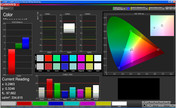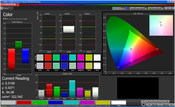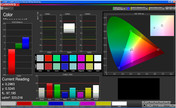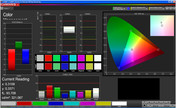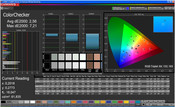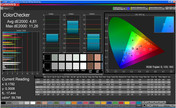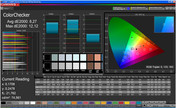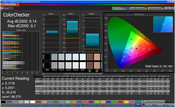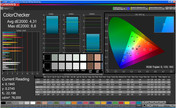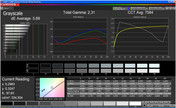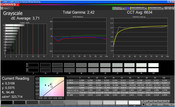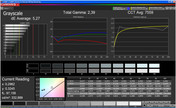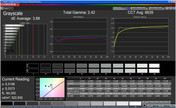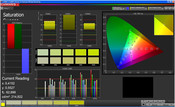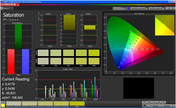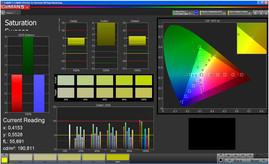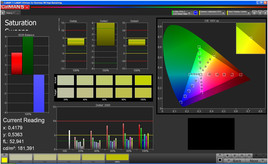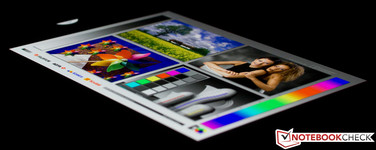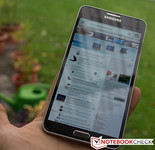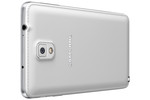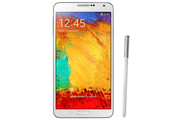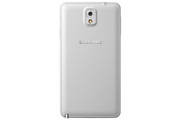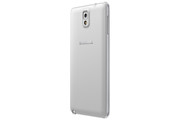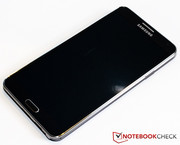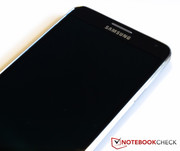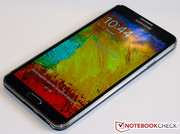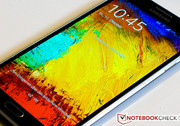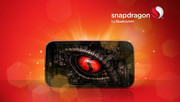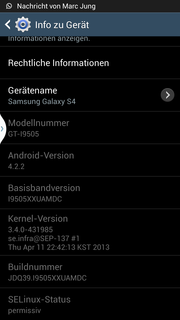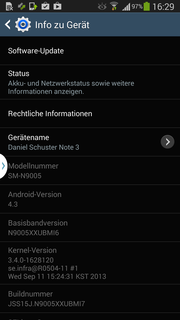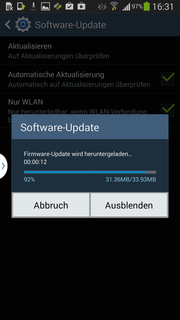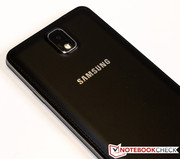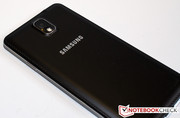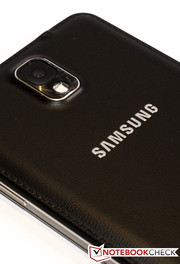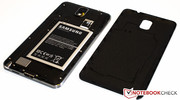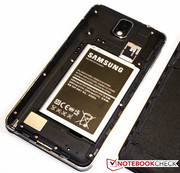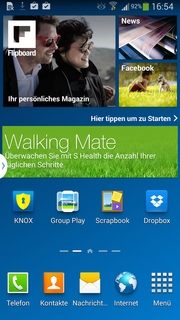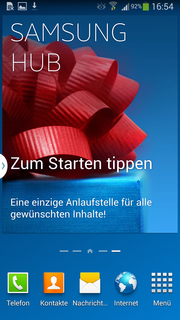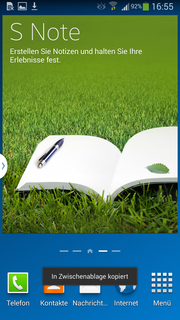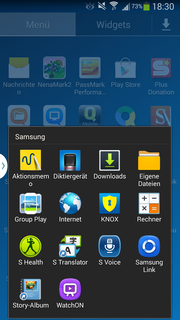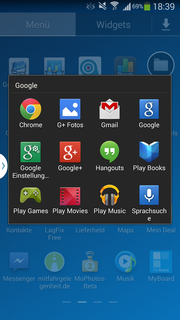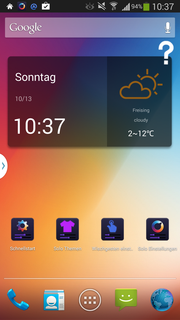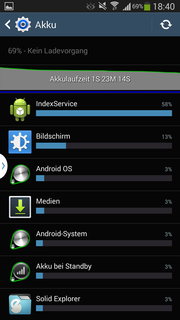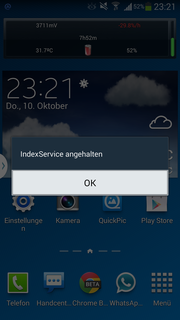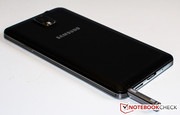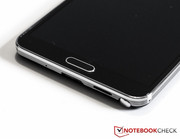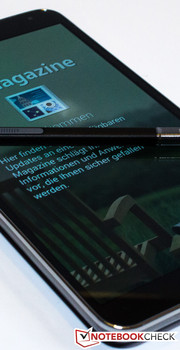Review Samsung Galaxy Note 3 SM-N9005 Smartphone
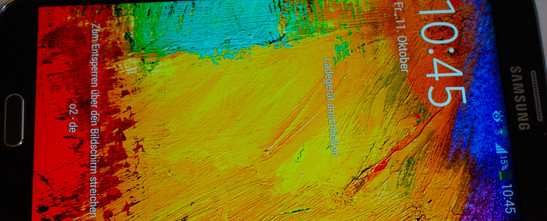
For the original German review, see here.
Pretty much exactly one year has passed since the introduction of the Samsung Galaxy Note II, thus it is about time the successor to Samsung's large-screen flagship line hit the market. Fortunately, the Galaxy Note 3 does not disappoint in terms of innovations, at least on paper: The display has once again grown, its diagonal measuring 14.48 cm (5.7 inches) while having been upgraded to Full HD resolution at the same time. It is powered by a quad-core Snapdragon 800 (running at 2.3 GHz), Qualcomm's newest SoC masterpiece which is accompanied by a staggering 3 GB of RAM. Of course, the S-Pen, the poster child of the Galaxy Note range, is on board as well, having learned a number of new tricks. As always, it can be stowed away within the device. In addition, the Galaxy Note 3 is the first device to feature a USB 3.0 port. Only the camera (13 megapixels) remains unchanged with respect to the one used in the Galaxy S4.
The differences between the Galaxy Note II and its successor appear to be enormous. Whether Samsung is able to translate all of this into a great user experience as well, turning its new flagship device into a worthwhile investment for its potential customers, will be examined in our in-depth review.
As is always the case with Galaxy range smartphones, the Note 3 is made from plastics. At first glance, the rear cover looks like it has been made from leather (it even comes with fake stitching!), but this is not the case. The sides look like aluminum, but they, too, are made from silver-colored polycarbonate. Still, the Note 3 feels and looks like a sturdy premium device. The weight is a nice surprise, too - 168 grams (5.9 ounces) is not too shabby for a 5.7-inch device. The Note 3 could have been thinner as it is 0.4 mm thicker than the Galaxy S4. The Note 3 is also as tall as its predecessor at 151.2 mm (~6 inches) while being slightly narrower (79.2 mm vs. 80.5 mm) (~3.1 vs. 3.2 inches).
Overall, no huge surprises here - at least not if one has touched a Galaxy-branded smartphone before.
The overall concept of the Galaxy Note 3 stays close to that of other Samsung Galaxy variants. We are happy to see that Samsung continues to use a physical home button (as well as soft keys for "back" and "menu") right below the display itself. LG's G2, for example, uses a significant portion of the screen itself to emulate these three navigation buttons, reducing its effective display size when compared to devices with physical buttons.
Apart from the usual power button and volume rocker, the Note 3 also comes equipped with an S-Pen slot at the bottom of the device. Great: The battery is fully user-accessible and user-replaceable (the back panel can be taken off) and the internal storage can easily (and economically) be expanded via micro SD cards.
Software
Immediately after booting for the first time, we were "encouraged" to install a system update, with a second update following within the same week. By now, our test device is running on Android 4.3, the newest iteration of Google's operating system. We encountered a nasty problem during the first few minutes of our review: The power consumption was extremely high and every minute an error box ("index service stopped") popped up. Due to this error, the smartphone was basically unusable for a few seconds each minute. After several days, we noted that the inserted SD card was to blame. However, even reformatting the storage device did not solve the problem - only a complete removal of the card ended our troubles. This is definitely a problem where the manufacturer will have to react fast - the continuous indexing of all files on the card just puts too much strain on the SoC.
As usual, Samsung includes a lot of bloatware and homegrown apps with the Note 3. In addition, a number of S-Pen-related apps come preinstalled.
Communication & GPS
The Galaxy Note 3 ships with more than enough communication modules. The Wi-Fi wireless for accessing the web at home or at the office supports all current standards (802.11 ac/b/g/n, thus including dual-band mode), provided the router does so, too. Maximum LTE speeds of 150 Mbit/s via numerous frequency bands (800/850/900/1800/2100/2600 MHz) are possible. In addition to the standard 3.5mm audio jack, Bluetooth 4.0 for establishing low-energy wireless connections to a number of end devices is on board as well. Naturally, a Samsung flagship smartphone nowadays cannot ship without NFC support for the emerging near-field communications standard. Handily, the Galaxy Note 3 is also able to double as a universal remote control (for TVs and other multimedia devices) due to its optical infrared port on top of the smartphone. During our tests, all wireless modems worked flawlessly at all times, without any unexpected connection interruptions. Reception and transmission quality were constantly high.
The Galaxy Note 3 comes with an aGPS module (including GLONASS). In order to test the quality of this module, we are comparing its precision to that of a full-blown outdoor navigation system made by Garmin during a real-life bicycle ride. Unfortunately, both modules could have worked better. Close to the crossing, some deviations from the actual route can be noted, but things got even less precise once we entered the forest patch. Such an imprecision in terms of locating the exact route also leads to wrong results in terms of the overall distance we rode. The GPS module used in the Apple iPhone 5C is definitely better.
Telephone Functions & Speech Quality
It may be hard to believe, but the Galaxy Note 3 is also still a telephone - and it actually works very well as such. As long as the signal strength did not hit rock bottom, we were always capable of understanding our partner at the other end clearly and vividly (as was he). The speakerphone does a satisfying job, too, fulfilling our expectations.
Cameras & Multimedia
"Never change a winning team." That seems to have been the idea behind reusing the Galaxy S4's camera modules in the Galaxy Note 3. After all, the sensor (13 megapixels) had already done an admirable job in our review of the Galaxy S4 a few months ago. Thus, we are not going to go into any more details here, letting the test images speak for themselves instead.
Accessories & Warranty
The Note 3 ships with the obligatory In-Ear headset as well as a modular power adapter. Since the Galaxy Note 3.0 offers a USB 3.0 port, such a cable is included as well.
The standard warranty of 24 months includes a bring-in service only (all Samsung service partners are okay, as is sending in the device). No warranty extensions are available from Samsung.
Input Devices & Handling
As usually with smartphones, most of the input and navigation is done with the help of the touchscreen. The one which is built into the Galaxy Note 3 is not only extremely fast in registering and interpreting touch commands (as well as display rotations), but also comes with S-Pen support. The S-Pen is an active digitizer (with one button at the side) which can be stored away in the chassis of the Note 3. Pulling the pen out of its slot automatically opens a menu on the screen with a number of different command options. The pen is not only very simple to use, but it is also extremely precise - making it viable to use the display in pretty much the same fashion as an old-school notebook. All of this is well done, but we ourselves still did not use it too often.
Typing on the virtual keyboard feels like bliss. After all, a diagonal of 5.7 inches leaves more than enough space for a generous keyboard layout, no matter whether it is being used in portrait or landscape mode (in the latter case, the keyboard uses up even more than 50% of the available screen real estate).
Its 5.7-inch display turns the Galaxy Note 3 into one of the largest smartphones on the market right now, even though it feels rather compact next to some especially huge phablets such as the Sony Xperia Z Ultra. The newest Galaxy Note variant stays true to the current trend towards ever-larger smartphone screens, adding 0.15 inches to its already challenging (in terms of handling) predecessor. To be fair, the concept seems to work out. In addition, Samsung has actually managed to slim down the chassis when compared to the Galaxy Note 2, both in terms of thickness and width. The display has seen another (unsurprising) upgrade, too, now sporting the same Full HD resolution as its smaller sibling, the Galaxy S4.
The average display brightness is 342.2 cd/m² as measured with X-Rite i1Pro 2 is quite good. Its brightness homogeneity? Not so much, as its 81% is not as great as the superb 95% of the Samsung Galaxy S4. As a Super AMOLED display is used, blacks are almost perfectly dark, leading to a basically infinite contrast ratio - which strongly enhances the readability of all screen contents under direct sunlight.
| |||||||||||||||||||||||||
Brightness Distribution: 81 %
Center on Battery: 331 cd/m²
Contrast: 3350:1 (Black: 0.1 cd/m²)
ΔE ColorChecker Calman: 6.14 | ∀{0.5-29.43 Ø4.78}
ΔE Greyscale Calman: 5.27 | ∀{0.09-98 Ø5}
Gamma: 2.39
CCT: 7559 K
A number of different display modes can be selected under the "system settings" tab, ranging from "standard" to "dynamic", "photo" and "video". The additional option "photo AdobeRGB" makes it possible to achieve coverage of almost the entire AdobeRGB color space. Still, reds tend to be under-saturated in all of these modes, as do some other colors. The strongest color saturation, leading to the most vivid color experience, can be had in "video" mode. Grayscale rendition is great, coming close to the reference curve unless the "dynamic" mode is selected, which leads to an unsatisfactory deviation from the ideal color temperature values.
As extreme contrast ratios and great maximum brightness are crucial for outdoor usability of a smartphone, the Galaxy Note 3 fares extraordinarily well even under difficult lighting conditions, delivering a near-perfect experience (if the brightness is set to "auto", an extra-boost applies under direct sunlight).
In terms of viewing angle stability, the Super AMOLED display shows no weaknesses. Even under extremely narrow angles, color rendition and contrast ratio remain superb, faring much better than, for example, the display of the Sony Xperia Z Ultra.
The Galaxy Note 3 offers more than enough performance for almost everything that can be thrown at it. The 5.7-inch device is powered by Qualcomm's Snapdragon 800, as are its competitors made by LG and Sony. The MSM8974 quad-core SoC is based on the ARMv7 instruction set, being manufactured via a 28-nm process. Each core is clocked at 2.3 GHz, allowing the chip to play QFHD videos (Quad Full HD, 3840x2160 pixels). An unprecedented amount of 3 GB of LPDDR3-RAM (800 MHz) is more than the already lush 2 GB used in the LG G2 or the Sony Xperia Z Ultra. In addition, the Note 3 is the first smartphone to make use of a USB 3.0 port. Not only does this increase the data transfer rate when copying files onto the internal storage, but it also allows (in theory) for quicker charging via the USB ports of a PC, increasing the 500 mA current which can be carried via a USB 2.0 data cable to up to 900 mA.
As we had already seen with other smartphones shipping with the same SoC, the performance levels achievable with the Snapdragon 800 are enormous, clearly beating most every other SoC in almost all benchmarks. Even though we might already be able to make an educated guess at the performance of the Samsung Galaxy Note 3, our test device will still have to prove itself during a number of "experiments", starting with synthetic benchmarks such as "GFXBench 2.7". Both the Sony Xperia Z Ultra and the LG G2 were able to reach slightly more than 20 fps, but the Note 3 is even 10% faster. Similar results can be obtained when different benchmarks are run, almost routinely beating the Galaxy S4 by around 40% while basically always staying ahead of both the LG G2 and the Sony Xperia Z Ultra - although both devices use the same SoC.
| GFXBench (DX / GLBenchmark) 2.7 | |
| T-Rex Onscreen (sort by value) | |
| Samsung Galaxy Note 3 SM-N9005 | |
| LG G2 | |
| Samsung Galaxy S4 GT-I9505 | |
| Sony Xperia Z Ultra | |
| Apple iPhone 5S | |
| 1920x1080 T-Rex Offscreen (sort by value) | |
| Samsung Galaxy Note 3 SM-N9005 | |
| LG G2 | |
| Samsung Galaxy S4 GT-I9505 | |
| Sony Xperia Z Ultra | |
| Apple iPhone 5S | |
| Epic Citadel - Ultra High Quality (sort by value) | |
| Samsung Galaxy Note 3 SM-N9005 | |
| LG G2 | |
| Samsung Galaxy S4 GT-I9505 | |
| Sony Xperia Z Ultra | |
| Geekbench 3 | |
| 32 Bit Multi-Core Score (sort by value) | |
| Samsung Galaxy Note 3 SM-N9005 | |
| LG G2 | |
| Samsung Galaxy S4 GT-I9505 | |
| Sony Xperia Z Ultra | |
| Apple iPhone 5S | |
| 32 Bit Single-Core Score (sort by value) | |
| Samsung Galaxy Note 3 SM-N9005 | |
| LG G2 | |
| Samsung Galaxy S4 GT-I9505 | |
| Sony Xperia Z Ultra | |
| Apple iPhone 5S | |
| PassMark PerformanceTest Mobile V1 - System (sort by value) | |
| Samsung Galaxy Note 3 SM-N9005 | |
| LG G2 | |
| Samsung Galaxy S4 GT-I9505 | |
| Sony Xperia Z Ultra | |
| Apple iPhone 5S | |
Browser-based tests are less SoC-dependent than most synthetic offline benchmarks mentioned above. In addition, these tests make it possible to compare Windows Phone and iOS devices as well. Like all of its Android competitors, the Galaxy Note 3 tends to fare worse than the new iPhone 5S. Still, the overall results remain great, being more than adequate for keeping its status as a high-end device.
| Browsermark - --- (sort by value) | |
| Samsung Galaxy Note 3 SM-N9005 | |
| LG G2 | |
| Sony Xperia Z Ultra | |
| Nokia Lumia 1020 | |
| Apple iPhone 5S | |
| Samsung Galaxy S4 GT-I9505 | |
| HTC One | |
| Peacekeeper - --- (sort by value) | |
| Samsung Galaxy Note 3 SM-N9005 | |
| LG G2 | |
| Sony Xperia Z Ultra | |
| Nokia Lumia 1020 | |
| Apple iPhone 5S | |
| Samsung Galaxy S4 GT-I9505 | |
| HTC One | |
| Octane V1 - Total Score (sort by value) | |
| Samsung Galaxy Note 3 SM-N9005 | |
| LG G2 | |
| Sony Xperia Z Ultra | |
| Nokia Lumia 1020 | |
| Apple iPhone 5S | |
| Samsung Galaxy S4 GT-I9505 | |
| HTC One | |
| Mozilla Kraken 1.0 - Total (sort by value) | |
| Samsung Galaxy Note 3 SM-N9005 | |
| LG G2 | |
| Sony Xperia Z Ultra | |
| Nokia Lumia 1020 | |
| Apple iPhone 5S | |
| Samsung Galaxy S4 GT-I9505 | |
| HTC One | |
* ... smaller is better
The Android app "AndroBench 3" is designed to bring the flash memory of any smartphone to its knees. Nevertheless, while the LG G2 already delivered great results during this test, the Galaxy Note 3 is no slug itself. In two of four tests - those measuring read speeds -, the LG G2 takes the lead by 4%, actually beating Samsung's newest flagship device. While measuring write speeds, the Galaxy Note 3 turns out to be the clear victor by up to 40%. Other competitors stand no chance at all against the sheer raw speed of our test device.
Videos & Games
Qualcomm claims that its Snapdragon 800 SoC has no problems with QFHD video playback. With such specs, what could go wrong? And indeed, our own observations confirm Qualcomm's assertions. Unsurprisingly, the Galaxy Note 3 does not exhibit any noticeable performance drops when it comes to demanding 3D games as well. Of course, 2D games such as "Angry Birds" or "Where's my Perry" are even less of an issue.
Temperature
In terms of heat dissipation, Samsung seems to have done everything right. Even under full load, our test device does not exceed 34.2 degrees Celsius (93.56 degrees Fahrenheit) on the front and 33.7 degrees (92.66 Fahrenheit) at the back, never even coming close to 40 degrees (104 Fahrenheit; temperatures above are seen as being "uncomfortable" by us). As long as not much strain is put on the hardware, the temperature plateaus at around 28 degrees (82.4 Fahrenheit). Even the power adapter is well-behaved: Although its maximum temperature of 39 degrees Celsius (102.2 Fahrenheit) can indeed be felt, it never becomes uncomfortably hot.
(+) The maximum temperature on the upper side is 39.1 °C / 102 F, compared to the average of 35.2 °C / 95 F, ranging from 21.9 to 247 °C for the class Smartphone.
(+) The bottom heats up to a maximum of 38.4 °C / 101 F, compared to the average of 34 °C / 93 F
(+) In idle usage, the average temperature for the upper side is 28.7 °C / 84 F, compared to the device average of 32.9 °C / 91 F.
Speakers
The mono speaker offers acceptable sound quality - meaning, it is sufficient for occasional use, unless very high standards are expected - with low distortion levels, high maximum volume and a decent balance between higher frequencies and bass. Nice: Due to its location at the bottom of the device, the speaker does not get covered when the device is put on a table or other flat surface. Of course, external solutions are always an option (and in many cases a preferable one) thanks to the numerous connectivity options for the Galaxy Note 3.
Power Consumption
The power consumption serves as a first indicator for the expected battery runtime. Fortunately, the Note 3 proves to be about as power-hungry as other high-end devices. The display of the LG G2 is noticeably smaller, leading to lower power consumption levels especially when set to maximum brightness, specifically 3.8 - 4.8 Watts instead of the 4.3 - 6.5 Watts the Galaxy Note 3 requires under full load. While idle or barely strained, both need the same 0.4 to 1.4 Watts. Standby requires 0.1 Watts, while turning the Note 3 off brings this value down to exactly 0.0 Watts.
| Off / Standby | |
| Idle | |
| Load |
|
Key:
min: | |
Battery Life
The battery used in the Galaxy Note 3 is not only user-replaceable, but also decently sized: Its capacity of 12.16 Wh (3200 mAh) is even (slightly) more impressive than the huge battery of the LG G2, coming down to the same battery that has also been employed in the Galaxy Mega 6.3. But this is where the similarities end, with the Galaxy Note exhibiting exemplary battery runtimes during at least two of three scenarios. While idle (with the screen brightness set to minimum), our test device survives for a possibly record-breaking 36 hours and 36 minutes. Just as good are the results of our Wi-Fi test where we open another website every 30 seconds while the display brightness is set to 150 cd/m² (60% in this case). The resulting battery runtime comes down to 18 hours. Only when all four cores of the CPU are under full load and when all wireless modems are activated as well does the power consumption increase considerably, reducing the battery runtime to 4:15 h, still much more than anything even the LG G2 accomplishes. In addition, charging the phone from 0% to 100% takes a mere 2:20 h.
Verdict
Those who have always been fond of the Note series will definitely already have cast an eye at Samsung's newest flagship - and rightfully so, as the Galaxy Note 3 is more than just an ordinary successor to the Galaxy Note II. Staying true to the trend of ever-larger smartphone screen sizes, the display of the Note 3 has grown as well; albeit in moderation, (the device is actually smaller and lighter than its predecessor, partially thanks to smaller bezels). Qualcomm's ultra-fast Snapdragon 800 and 3 GB of RAM speak for themselves. Even during real-life usage, the smartphone barely ever breaks a sweat, remaining extremely fast and responsive. Another big pro is the Note 3's absurdly phenomenal battery life. The camera module is the same as the one used in the older Galaxy S4, but neither Samsung nor our reviewers feel much need for change in this regard. While we did not really take to the S-Pen (not using it much at all), it is surely an attractive feature with a number of useful application scenarios for those who need it.
Samsung pretty much nailed it with the Galaxy Note 3, creating a formidable smartphone. It is no bargain, currently retailing for around 650 Euros (~$891), but this is still considerably less than the 799 Euros (~$1095) the 32 GB variant of the iPhone 5S costs. For those who are in need of an even larger device, the 6.44-inch Sony Xperia Z Ultra (approx. 600 Euros/~$822) might do the trick. The 5.2-inch LG G2, on the other hand, might be a great "smaller" alternative at 480 Euros (~$658).





